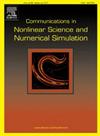Fractional derivative of Hermite fractal splines on the fractional-order delayed neural networks synchronization
IF 3.4
2区 数学
Q1 MATHEMATICS, APPLIED
Communications in Nonlinear Science and Numerical Simulation
Pub Date : 2024-10-23
DOI:10.1016/j.cnsns.2024.108399
引用次数: 0
Abstract
The purpose of this research is twofold. First, the master–slave synchronization of fractional-order neural networks is explored with time delays using aperiodic intermittent control. Then we present a sufficient condition for master–slave synchronization of delayed fractional-order neural networks via average-width intermittent control technique. A numerical simulation is used to demonstrate the efficacy of the derived results. Second, a novel investigation of the Caputo-fractional derivative of Hermite fractal splines is accomplished. Moreover, its box counting dimension is estimated and related with the Caputo-fractional order. Additionally, we propose an image encryption algorithm utilizing the semi-tensor product (STP). The efficiency of the algorithm is evaluated through the application of statistical measures.
关于分数阶延迟神经网络同步的赫米特分形样条的分数导数
这项研究有两个目的。首先,利用非周期性间歇控制技术探讨了带有时间延迟的分数阶神经网络的主从同步问题。然后,我们提出了通过平均宽度间歇控制技术实现延迟分数阶神经网络主从同步的充分条件。通过数值模拟证明了推导结果的有效性。其次,对 Hermite 分形样条曲线的 Caputo 分形导数进行了新颖的研究。此外,我们还估算了其盒计维度,并将其与卡普托分形阶数联系起来。此外,我们还提出了一种利用半张量积(STP)的图像加密算法。该算法的效率通过应用统计量进行了评估。
本文章由计算机程序翻译,如有差异,请以英文原文为准。
求助全文
约1分钟内获得全文
求助全文
来源期刊

Communications in Nonlinear Science and Numerical Simulation
MATHEMATICS, APPLIED-MATHEMATICS, INTERDISCIPLINARY APPLICATIONS
CiteScore
6.80
自引率
7.70%
发文量
378
审稿时长
78 days
期刊介绍:
The journal publishes original research findings on experimental observation, mathematical modeling, theoretical analysis and numerical simulation, for more accurate description, better prediction or novel application, of nonlinear phenomena in science and engineering. It offers a venue for researchers to make rapid exchange of ideas and techniques in nonlinear science and complexity.
The submission of manuscripts with cross-disciplinary approaches in nonlinear science and complexity is particularly encouraged.
Topics of interest:
Nonlinear differential or delay equations, Lie group analysis and asymptotic methods, Discontinuous systems, Fractals, Fractional calculus and dynamics, Nonlinear effects in quantum mechanics, Nonlinear stochastic processes, Experimental nonlinear science, Time-series and signal analysis, Computational methods and simulations in nonlinear science and engineering, Control of dynamical systems, Synchronization, Lyapunov analysis, High-dimensional chaos and turbulence, Chaos in Hamiltonian systems, Integrable systems and solitons, Collective behavior in many-body systems, Biological physics and networks, Nonlinear mechanical systems, Complex systems and complexity.
No length limitation for contributions is set, but only concisely written manuscripts are published. Brief papers are published on the basis of Rapid Communications. Discussions of previously published papers are welcome.
 求助内容:
求助内容: 应助结果提醒方式:
应助结果提醒方式:


